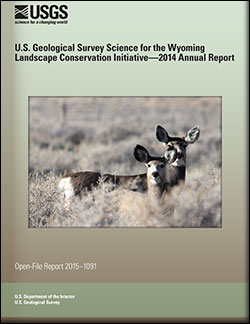|
|

This is a collaborative, two-part project to compile and analyze resource data to support WLCI efforts. Part 1 entails directing data synthesis and assessment activities to ensure that they will inform and support the WLCI LPDTs and Coordination Team in their conservation planning efforts, such as developing conservation priorities and strategies, identifying priority areas for conservation actions, evaluating and ranking conservation projects, and evaluating spatial and ecological relations between proposed habitat projects and WLCI priorities. In FY2014, we helped the Coordination Team complete the WLCI Conservation Action Plan and BLM’s annual report, and we provided maps and other materials to assist with ranking...
|

This data collection is associated with the project: “Status and Trends of Deciduous Communities in the Bighorn Mountains”. It contains the project study area, model evaluation data, model input data, and model output data in the form of probability of occurrence rasters for deciduous and coniferous species, as well as a synthesis map. The aim of the study is to assess the current trends of deciduous communities in the Bighorn National Forest in north-central Wyoming. The data here represents phase I of the project, completed in FY2017. The USGS created a synthesis map of coniferous and deciduous communities in the Bighorn Mountains of Wyoming using a species distribution modeling approach developed in the Wyoming...
|

The standardized precipitation evapotranspiration index (SPEI) was summarized for the Upper Green River Basin to quantify climate variability over the last century. The SPEI incorporates both precipitation and temperature data, therefore the index has the capacity to include the effects of temperature variability on drought. The SPEI considers the difference between precipitation and potential evapotranspiration to calculate a climatic water balance at a given time scale (Vicente-Serrano et al. 2010). The number of standard deviations the climatic water balance deviates from the long-term mean for a given time period represents the SPEI for the time period. Here, I calculated the SPEI for each water year (Oct–Sept)...
|

Data included in this data set are from edge-of-field surveys that recorded the presence of erosional features, cover of vegetation and bare ground, and management activities (e.g., haying) on 1092 fields that had expired from three types of conservation practices (grassland, wetland, and wildlife) in the Conservation Reserve Program. Field sampling data were recorded across six US Department of Agriculture Farm Production Regions (Corn belt, Lake states, Mountain, Northern plains, Pacific, Southern plains) from 2017 to 2018. The study area encompassed all or part of 14 states: Washington, Oregon, Idaho, Montana, North Dakota, South Dakota, Minnesota, Iowa, Missouri, Colorado, Nebraska, Kansas, Oklahoma, and Texas....
Categories: Data;
Tags: CRP,
Central United States,
Colorado,
Conservation Reserve Program,
Idaho, All tags...
Iowa,
Kansas,
Land Use Change,
Minnesota,
Missouri,
Montana,
Nebraska,
North Dakota,
Oklahoma,
Oregon,
South Dakota,
Texas,
USGS Science Data Catalog (SDC),
Washington,
Western United States,
bare soil,
biota,
canopy cover,
ecosystems,
erosion,
grass management,
grassland ecosystems,
grazing,
gullies,
haying,
mowing,
native forbs,
native grasses,
noxious forbs,
noxious grasses,
pedastaling,
rills, Fewer tags
|

This is the seventh report produced by the U.S. Geological Survey (USGS) for the Wyoming Landscape Conservation Initiative (WLCI) to detail annual activities conducted by the USGS for addressing specific management needs identified by WLCI partners. In FY2014, there were 26 projects, including a new one that was completed, two others that were also completed, and several that entered new phases or directions. The 26 projects fall into several categories: (1) synthesizing and analyzing existing data to identify current conditions on the landscape and using the data to develop models for projecting past and future landscape conditions; (2) monitoring indicators of ecosystem conditions and the effectiveness of on-the-ground...
|
View more...
|